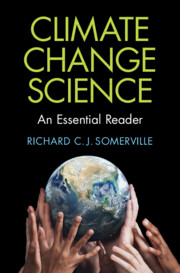Book contents
- Climate Change Science
- Reviews
- Climate Change Science
- Copyright page
- Dedication
- Epigraph
- Contents
- Preface
- Acknowledgments
- Part I Eight Articles from the Bulletin of the Atomic Scientists
- Part II Understanding and Communicating Climate Change Science
- Part III Scientific Investigations of the Climate System
- 13 The Greenhouse Effect
- 14 The Keeling Curve
- 15 The Temperature Record
- 16 Climate in the Future
- 17 Numerical Weather Prediction
- 18 Modeling the Climate System
- 19 Climate Feedbacks
- 20 Predictability
- 21 How Climate Models Work
- 22 The Sixth Assessment Report of the IPCC
- Part IV The Future
- Appendix: Curriculum Vitae of Richard C. J. Somerville
- Glossary
- Resources: Recommended Websites and Books
- References
- Index
19 - Climate Feedbacks
from Part III - Scientific Investigations of the Climate System
Published online by Cambridge University Press: 13 November 2025
- Climate Change Science
- Reviews
- Climate Change Science
- Copyright page
- Dedication
- Epigraph
- Contents
- Preface
- Acknowledgments
- Part I Eight Articles from the Bulletin of the Atomic Scientists
- Part II Understanding and Communicating Climate Change Science
- Part III Scientific Investigations of the Climate System
- 13 The Greenhouse Effect
- 14 The Keeling Curve
- 15 The Temperature Record
- 16 Climate in the Future
- 17 Numerical Weather Prediction
- 18 Modeling the Climate System
- 19 Climate Feedbacks
- 20 Predictability
- 21 How Climate Models Work
- 22 The Sixth Assessment Report of the IPCC
- Part IV The Future
- Appendix: Curriculum Vitae of Richard C. J. Somerville
- Glossary
- Resources: Recommended Websites and Books
- References
- Index
Summary
A feedback is something that happens in response to a prior cause, and which then itself makes a change in what caused it. It is the modification or control of a process or system by its results or effects. The challenge in making climate models realistic is largely that of understanding these feedback processes and incorporating them in models. As the air warms, does water vapor increase? To what extent? How much does that affect the warming? Do ice and snow melt? How rapidly? Does that change the reflectivity of the Earth’s surface and affect the warming? Does the ocean circulation change? In what ways? How does that affect climate? Do the clouds change? Are they more plentiful? Less plentiful? Higher? Lower? Darker? Lighter? How do they feed back to the climate? We need quantitative answers to all these questions. For example, we are not asking the qualitative question of whether clouds warm us or cool us. We know that they do both. Rather, we are asking the hard, quantitative question: Which of those two events is dominant, the cloud’s contribution to the greenhouse effect (warming) or the cloud’s contribution to reflecting away sunlight (cooling)?
Information
- Type
- Chapter
- Information
- Climate Change ScienceAn Essential Reader, pp. 113 - 122Publisher: Cambridge University PressPrint publication year: 2025
Accessibility standard: WCAG 2.0 A
Why this information is here
This section outlines the accessibility features of this content - including support for screen readers, full keyboard navigation and high-contrast display options. This may not be relevant for you.Accessibility Information
Content Navigation
Allows you to navigate directly to chapters, sections, or non‐text items through a linked table of contents, reducing the need for extensive scrolling.
Provides an interactive index, letting you go straight to where a term or subject appears in the text without manual searching.
Reading Order & Textual Equivalents
You will encounter all content (including footnotes, captions, etc.) in a clear, sequential flow, making it easier to follow with assistive tools like screen readers.
You get concise descriptions (for images, charts, or media clips), ensuring you do not miss crucial information when visual or audio elements are not accessible.
Structural and Technical Features
You gain clarity from ARIA (Accessible Rich Internet Applications) roles and attributes, as they help assistive technologies interpret how each part of the content functions.
